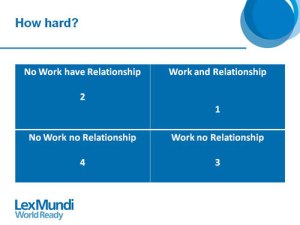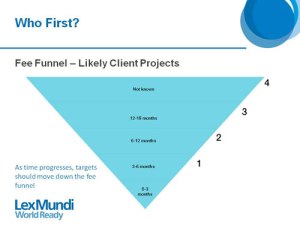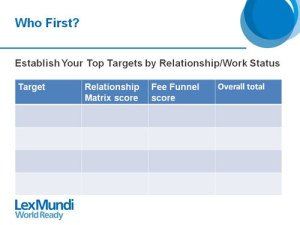Old Sales Dog, New Targeting Trick
At a recent gathering of marketing professionals from Lex Mundi member firms, David Sanders, from the Scotland member firm Maclay Murray & Spens, and I gave a presentation on components of the sales process that marketing professionals can and should “own.” One of these components is selecting target lists, which we are convinced should be the province of marketing professionals not only because they have the aptitude and tools to handle target selection, but also because it is a way for marketing professionals materially to contribute to the implementation of strategy. (In a sense, a firm’s strategy can be defined by the clients it wishes to have at some point in the future).
I’ve been guiding and/or participating in law firm targeting for years, but I am continually learning new tricks of the trade. In this instance, I was very impressed with David’s approach to prioritizing targets (including existing-client targets). He uses a simple, but powerful, scorecard comprised of two questionnaires posed to lawyers.
The first questionnaire, illustrated in the chart below, asks lawyers to rank clients or prospective clients potential clients based on the existence of current work and relationships. Targets wherein there is both work and relationships are assigned the highest score, 1. Those with no work and no relationships receive the lowest score, 4.
Next, as illustrated in the chart below, David asks lawyers to estimate the amount of time that will be required to consummate the next engagement. Opportunities that will close within the next 6 months are assigned a higher ranking, 1, than are opportunities that will close in the 12- to 18-month range, which are assigned a 3, or opportunities where it is not possible to estimate the closure date, which are assigned a 4.
The final step in this process is adding together the numbers from the two questionnaires in the chart below. Clients or prospective clients that represent the best combination of current relationships/work and least amount of time to reach closure receive an overall total of 2, and they are the ones that lawyers should prioritize for immediate client-development effort. Lawyers should focus on these clients or prospective clients at the expense of other targets, particularly those that receive scores of 5 or more.
Those of us who help lawyers with targeting certainly intuitively understand the necessity of prioritizing targets. It’s great that David Sanders has created such an easy-to-understand-and-implement tool to help lawyers, as well, grasp the importance of target-prioritization.





Steve, another good post. Tools like this help demystify the biz dev process